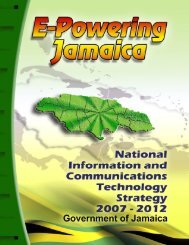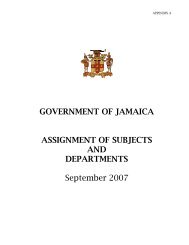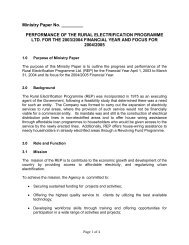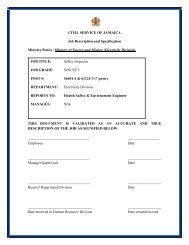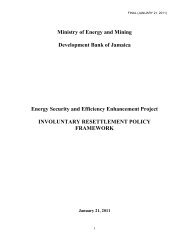Jamaica Biofuels Report - Ministry of Energy
Jamaica Biofuels Report - Ministry of Energy
Jamaica Biofuels Report - Ministry of Energy
Create successful ePaper yourself
Turn your PDF publications into a flip-book with our unique Google optimized e-Paper software.
support prices when they are too low to amortize investments in production. In that way, thefund would provide a hedge against investors’ risk <strong>of</strong> fluctuations in world oil prices.A funding mechanism along these lines would not have to be built in <strong>Jamaica</strong> from scratch. Thecountry already counts on the Development Bank <strong>of</strong> <strong>Jamaica</strong> and the Agricultural SupportServices Project, institutions that could play key roles in establishing and administering it.Feedstock and Electricity PricingTwo issues that arose in the formulation <strong>of</strong> the bi<strong>of</strong>uels policy were pricing arrangements forsugar cane produced by independent farmers and for independent power exported to theelectrical grid by processing installations. Although the feasibility study could estimate thecosts and benefits <strong>of</strong> bi<strong>of</strong>uel production, such an analysis cannot readily determine how theachievable benefits should be divided among interested parties. For example, the studyestimated that, at least in the case <strong>of</strong> cogeneration at one <strong>Jamaica</strong>n sugar mill, a price <strong>of</strong> $0.15per kWh for cogenerated electricity would result in an annual return <strong>of</strong> approximately 15percent. The study also estimated that the value <strong>of</strong> electricity to the national grid, expressedas avoided cost, was between $0.20 and $0.25 per kWh. Whether a return <strong>of</strong> 15% is sufficientto result in equity being invested in a new bi<strong>of</strong>uel cogeneration plant, and how the potentialnet benefit <strong>of</strong> $0.05 to $0.10 per kWh should be distributed among the investor, the utilityrate payer, and the public service company remains to be determined, presumably throughnegotiations among prospective producers, <strong>Jamaica</strong> Public Service, and the Office <strong>of</strong> UtilityRegulation.Similarly, cane prices paid to farmers by sugar mills have been based historically on theproduction <strong>of</strong> granular sugar and do not reflect any additional benefits associated withbioethanol or energy sales. As the sector become more multi-product oriented, a moresophisticated payment model will be needed to incentivize farmers to provide sugar mills withfeedstock that maximizes overall value. These pricing arrangements will require negotiationbetween the cane growers and the sugar mill estates and possibly others.Finally, the study estimates based on Brazilian experience that biodiesel from plants likecastor, and by extension jatropha, are unlikely to be produced economically without someform <strong>of</strong> subsidy. Such a subsidy may be justified as a means to slow urban migration or as an<strong>of</strong>fset against other costs associated with rural poverty. How such a subsidy, if justified, mightoperate, and at what level is another feedstock price-related subject for agreement among thegovernment and other parties involved in any prospective biodiesel industry.An expanded bi<strong>of</strong>uels task force could play a key role in identifying the parties, bringing themtogether, and providing a neutral forum for resolving differences and reaching agreement onhow to distribute the benefits <strong>of</strong> bi<strong>of</strong>uel ventures. The result would be to enlist thecooperation <strong>of</strong> all parties, so projects can move forward.110



